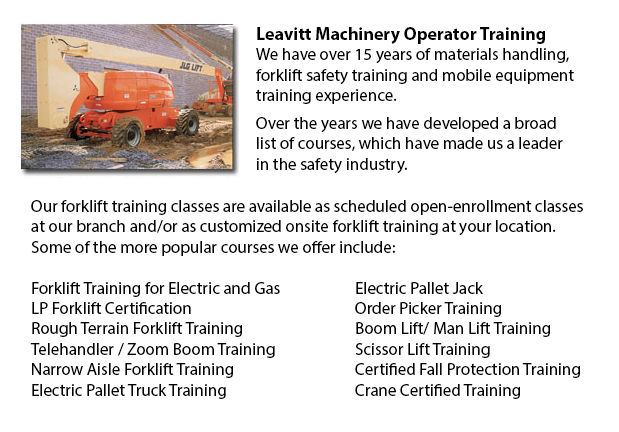
Manlift Training Penticton - There are lots of manlift training courses that offer a review of the manlift machinery. The practicum portion of the training is another essential part of the program. In this part the trainee has chance to show their practical abilities, their ability to operate the manlift safely. A prerequisite to Manlift training is the fall protection training, that may be included in the training based on the specific needs of the client.
Course Content
The program content consists of: the effect of doing unsafe acts or using unsafe machinery, pre-shift machine inspection and work area survey requirements, Review of load capacities, Lifting devise equipment definitions, safety decals and particular machine requirements, Review of related sections of the OSHA Standards and the CSA Standards and Review site particular Dangers, together with controls for safe operation of a lifting device.
Demonstration and Evaluation Content
Evaluation and demonstration content includes: making use of a signaler or a spotter when required; Proper personal protective equipment or likewise referred to as P.P.E. as required; making use of a correct fitting harness or fall arrest devise; Using a lift just on solid and level ground; Using the lift with all other workers clear of the job site; Aware of load restrictions etc. and other specs as set out by the manufacturer; Having all associated machine stored safely on the lift platform; Pre-shift work area survey and equipment inspection; Ensuring a smooth and safe operating speed for different plant conditions and isolating off the work area when major work projects are to be done.
Each of the trainees will undergo testing to make sure that they could safely operate their machine.
Manlift Safety
Since the manlift is capable of lifting personnel and materials over 20 feet in the air, these machinery pose a particular amount of risk and can be dangerous machinery if not operated correctly. Because the danger is so apparent, lift owners and operators are careful to correctly maintain their equipment and follow correct operating procedures and safety measures. The ratio of accidents involving this specific apparatus is fairly low.
The safety specifications for boom lifts and scissor lifts puts the burden for safe manlift operation on the user. You are responsible for knowing how to safely utilize the lift even if you just lease the equipment for one day. The most basic safety features on the machine are the operating manual and safety decals. These show important information regarding the safety machines, maintenance and operating procedures.
Newer lift models will come with manuals and decals in place. Technically, the operating manual should be kept on the lift itself. If you are buying a second-hand lift, it is vital to make sure that the manual is included and that essential decals haven't been painted over. The restraints which prevent operators from falling and the guardrails are other essential safety features. These are standard and mandatory on all kinds of lifts.
-
Forklift Certification Schools Penticton
Forklift Certification Schools Penticton - In North America, forklift certification is mandatory, making forklift training programs essential for both the business and their employees working as operators of forklifts. Forklift training focuses on sa... More -
Telehandler Training Courses Penticton
Telehandler Training Courses Penticton - The employer has the responsibility to make sure that their personnel are trained to work proficiently utilizing telehandler machinery. The workers have to be assessed for their ability to utilize the machine.... More -
Certified Fall Protection Training in Penticton
There are many injuries at work linked to falling and lots of fall-related deaths reported each and every year. Most of these instances might have been prevented with better training, better precautions in place, and by properly equipping employees b... More -
Zoom Boom Training Penticton
Zoom Boom Training Penticton - Zoom Boom Training is designed to train operators on variable reach forklifts. The objectives of the training are to impart an understanding of the physics of the machine, and to outline the operator's job. This course... More -
Crane Training Schools Penticton
Crane Training Schools Penticton - We have designed various Mobile Crane Operation programs at our Crane Training Schools. These programs are recommended for the experienced operator who needs re-certification or certification, and for inexperienced... More -
Aerial Lift, Boom Lift, Man Lift, Scissor Lift Training in Penticton
Lift tables or also referred to as scissor hoists can lift up both individuals and materials vertically. They are normally utilized in industrial, construction and commercial environments. Normally, the use of a scissor forklift is to lift and lower... More -
Forklift Training Program Penticton
Forklift Training Program Penticton - The forklift is a common powered industrial vehicle which is in wide use nowadays. They are occasionally known as hi los, lift trucks or jitneys. A departments store will utilize the forklift to unload and load m... More -
Overhead Crane Training Penticton
Overhead Crane Training Penticton - An overhead crane is a large crane used to move and lift huge, heavy objects that cannot be lifted by hand. An overhead crane is normally fixed in position while in use. These machines are capable of moving huge vo... More

Forklift Training Penticton
TOLL FREE: 1-888-254-6157
Penticton, British Columbia
forklifttrainingpenticton.com
Email Us
About Us


